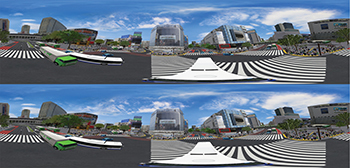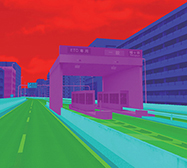In UC-win/Road, users can use Micro Simulation Player to import animation
files (*ani.txt) made by the PTV's VISSIM that is a traffic analysis tool
and to visualize traffic analysis results. This time we have implemented
a new function that transmits and compute realtime vehicle data to VISSIM
and reflects the data and the calculation result of surrounding vehicles
to UC-win/Road. The status of driving vehicle can be reflected to VISSIM
in real-time and 3D calculation results can be visualized with more reality.
The functions above are provided by not the simulation player but another
plug-in. VISSIM Ver.11 or newer version is supported.
Cooperation elements:
The API provided by VISSIM helps to connect to and cut from VISSIM, transmit
data, and obtain calculation result.
The following contents can be linked:
- Driving vehicle (location, speed)
- Surrounding vehicle (location, speed)
- Traffic light
Simulation flow:
When a simulation is started after associating vehicles and traffic lights
in both of UC-win/Road and VISSIM, UC-win/Road transmits the vehicle data
to VISSIM, and VISSIM sends the calculation result to UC-win/Road.
 |
 |
| Fig.3 Simulation cooperation |
Fig.4 Post process reflects the vehicle suspension |
|


